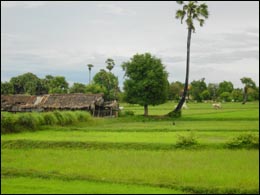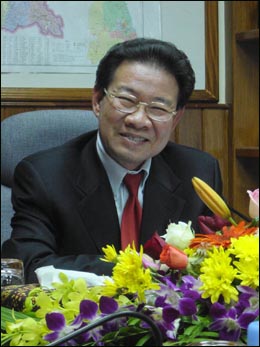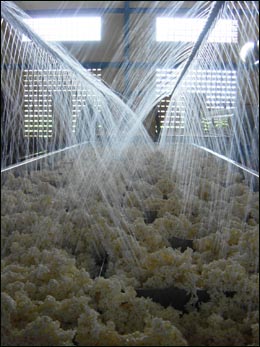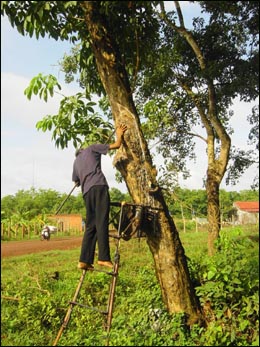 Agriculture Agriculture |

The agricultural sector, including rice farming,
livestock, forestry, and cultivation of other
crops, provides direct employment to more than
75% of Cambodia's labour force. According to the
Ministry of Finance, agriculture accounts for
37% of GDP. Excellent rice harvests in 1999 contributed
to Cambodia's better than expected economic growth.
With its large amount of arable land, ample rainfall,
and close proximity to the major ASEAN markets
of Thailand and Vietnam, Cambodia has strong growth
potential in the agriculture sector.
A number of plantation agriculture projects are
already underway in the areas of palm oil, cashew,
coffee, tea, and vegetable production.
 A growth
potential sector A growth
potential sector |
The government has taken note of the growth potential
of the sector as well as the important role increased
agricultural production can play in reducing rural
poverty in Cambodia. The
Ministry of Agriculture, Forestry and Fisheries
(www.maff.gov.kh)
has also been designated as one of four priority
ministries to receive expanded budgets.

The potential is tremendous. The employment of
new technology and the addition of capital will
produce rapid growth and significant gains. Government
of Cambodia also provides generous incentives
for foreign investors in the area of agricultural
production to further encourage growth in this
sector. As explained the Minister
of Agriculture, Forestry and Fisheries, H.E. Chan
Sarun, the ministry has established four main
priorities to develop the sector such as the diversification.
He mentioned "We can for instance develop
the aquaculture where we have already success
or products like tobacco, cashew nuts and coffee
destinated to the agro-industrial sector".
The second priority is to encourage the investment
on the agro-industrial sector, which lies "in
the center of our development policy in order
to give a way out for production and also create
an added value". The introduction of new
technologies and know how, with modernisation
and mechanisation of the sector will help increase
the production and profitability, and therefore
increase the investment. As the Minister underlined,
"We first of all implemented our tax policy,
establishing an exemption for the imports concerning
all materials needed by the farmers".
 Rice and
rubber, the most significant opportunities
for growth Rice and
rubber, the most significant opportunities
for growth |
Rice production accounts for approximately 15%
of GDP, yet yields remain low. Government efforts
to increase rice production have been quite successful
and led to an increase of 30% over the last five
years. With rice-import demand in Asia forecast
to grow by as much as 70% over the next thirty
years, there is certain to be an export market
for rice if Cambodian production increases. In
this field we have to underline that the Cambodian
rice, even through less competitive than its neighbours
such as Vietnam or China, has a higher quality
and have always been renowned. Nowadays the tendency
is to develop a bio rice of a superior quality.
Within this context national companies have taken
the opportunity and are selling their production
essentially to external markets. An example of
it is Angkor
Kasekam Roonroeung Co., Ltd. , with Mr. Chieu
Hieng as CEO, the company has invested heavily
into preliminary studies to find the best ground
and into modern equipment to guarantee the best
quality for a rice that is being exported to several
countries in the world. Bio-products is their
motto and the company actually forbids its farmers
to use any kind of chemical fertilizers.

|
Concerning rubber, it
is the one of the most significant opportunities
for growth in Cambodian agriculture. As for the
rice, the average quality of rubber in Cambodia
is particularly high despite a lack of certification
in the sector that is currently under achievement
with collaboration with the Malaysian certification
institute. Current levels of production are only
a quarter of their volume in the mid-1960s.

The main attraction in the sector and appeal
to foreign investors, from the government to develop
the sector, is the privatising of public rubber
plantations. In words of H.E. Ly Phalla, Director
General of the General Directorate of Rubber Plantations:
"Our main priority is to create jobs and
provide a reliable source of income to the farmers
(…) we know that we need foreign investors
to develop the industrial exploitation, they have
to meet our expectations and we have to fulfil
their needs too". In addition, close to 280.000
hectares of land are estimated to be available
and readily accessible for rubber production.
Since this is a labor-intensive industry, Cambodia's
relatively cheap labour would be an advantage
and the plantation directors are eager to receive
new partners: "In Cambodia we have about
280.000 Hectars of suitable red land (…)
for the rubber plantations, as you can imagine
there is plenty of room for new investors (…)
and we are actually carrying on a policy of partnership
research. We want to develop, during the coming
years, processing industries of the rubber in
order to be able to export products which have
an higher added value." said Mr. Mak Kim
Hong, Chairman and Managing Director of the biggest
rubber plantation in Cambodia, Chup Rubber Plantation.
 Fisheries Fisheries |
The fisheries sub-sector accounts for approximately
5% of Cambodia's GDP relative to livestock and
has a potential to increase its contribution to
economic growth. The government's goal is to increase
production while preserving environmental integrity
and maintain per capita consumption. One of the
priorities is to increase incomes through greater
value added activities, such as commercial shrimp
fanning for export.
Total
Fisheries Production (Click here)
Since domestic capacity for offshore fishing
is currently limited, the government will continue
to allow foreign access to Cambodia's fishing
grounds. The management of inland fisheries is
in fact, dominated by a system of lots or concessions,
auctioned out by the government to private business.
However, fishing lot boundaries are often not
clearly defined or communicated to local communities.
In order to protect people's live hood and natural
resources, various institutions have been piloting
another approach, namely community fisheries.
It has helped reduce illegal fishing by up to
60%.
 Forestry Forestry |
Close to 60% of Cambodia's land area is forested
and constitutes a major national asset. Nowadays
Cambodia produces honey, wood spirit, resin, rattan,
bamboo, cardamom, bark and medicinal plants from
its forested lands. Wood is also still the primary
source of fuel in Cambodia.
The government is in the process of developing
sustainable forestry management plans that will
both contribute to Cambodia's economic output
and be environmentally sound. To this end, the
Royal Government adopted a forestry sector strategy
which is based on three pillars: sustainable forest
concession management policy, where timber exploitation
is strictly controlled according to international
forestry standards; a system of protected areas
to preserve the country's unique biodiversity
and endangered species; and a substantially stronger
community forestry development program.
To establish a comprehensive legal framework
for forest management, the RGC issued a governmental
Decree on Forest Concession Management in February
2000. This decree has also been reinforced with
a Forestry
Law, drafted with technical assistance from
the ADB, and a government Decree on Community
Forestry to be submitted to the Council of Ministers
in the near future.
Despite the great improvements, there are still
factors limiting agricultural production including
unclear
land ownership, a lack of irrigation infrastructure,
inadequate transportation infrastructure. Nevertheless,
the country's infrastructure improved gradually
in the 1990s, largely due to massive infusions
of foreign assistance. Nowadays agricultural products
are massively produced in Cambodia and many international
companies have taken this opportunity.
|

